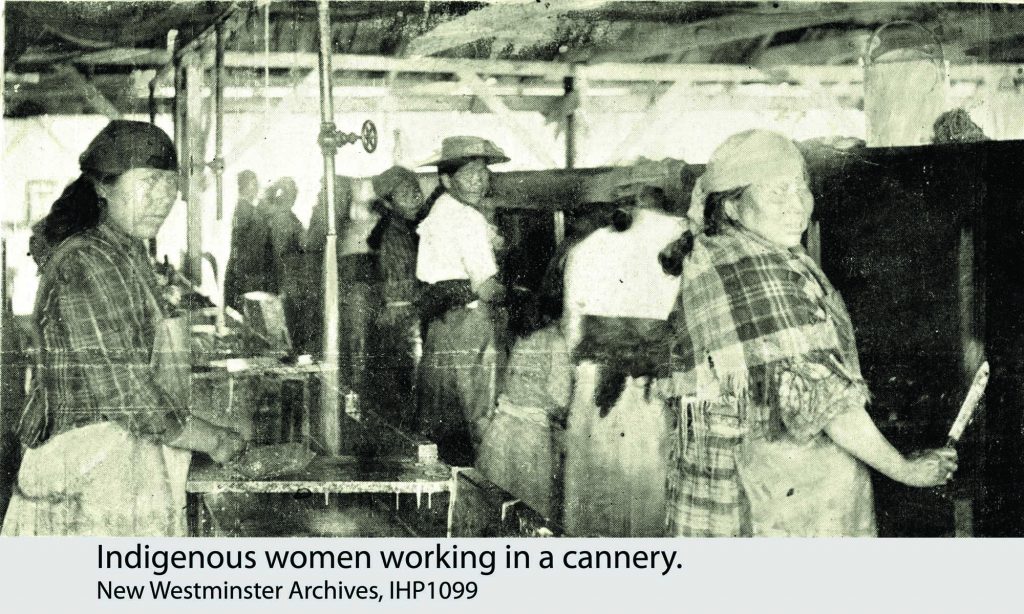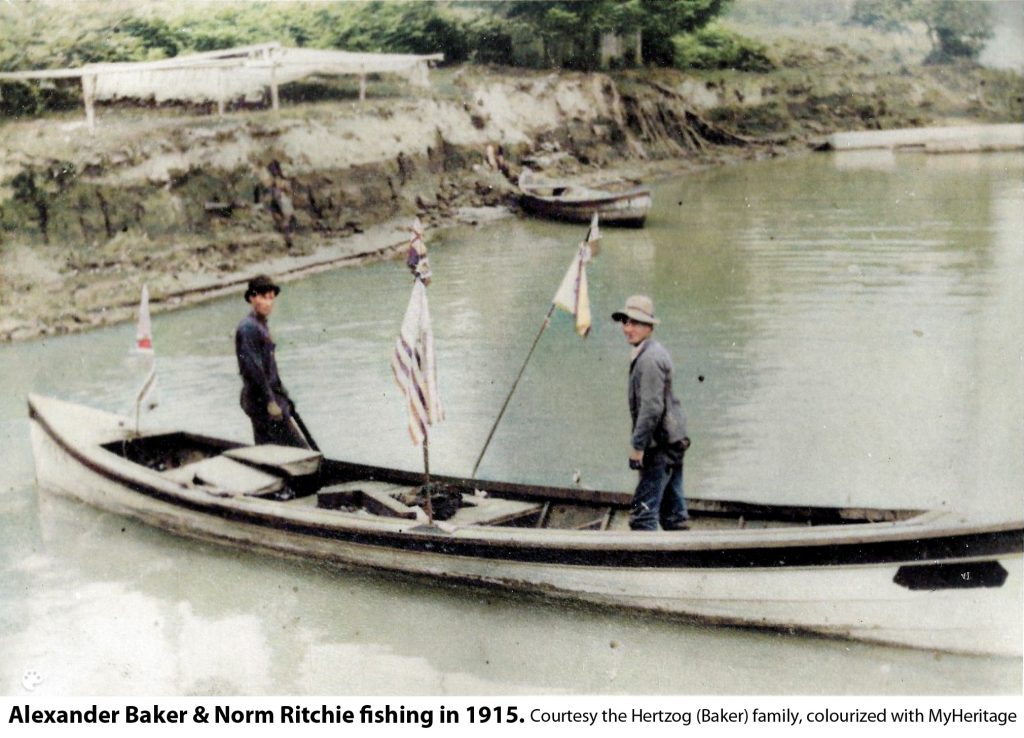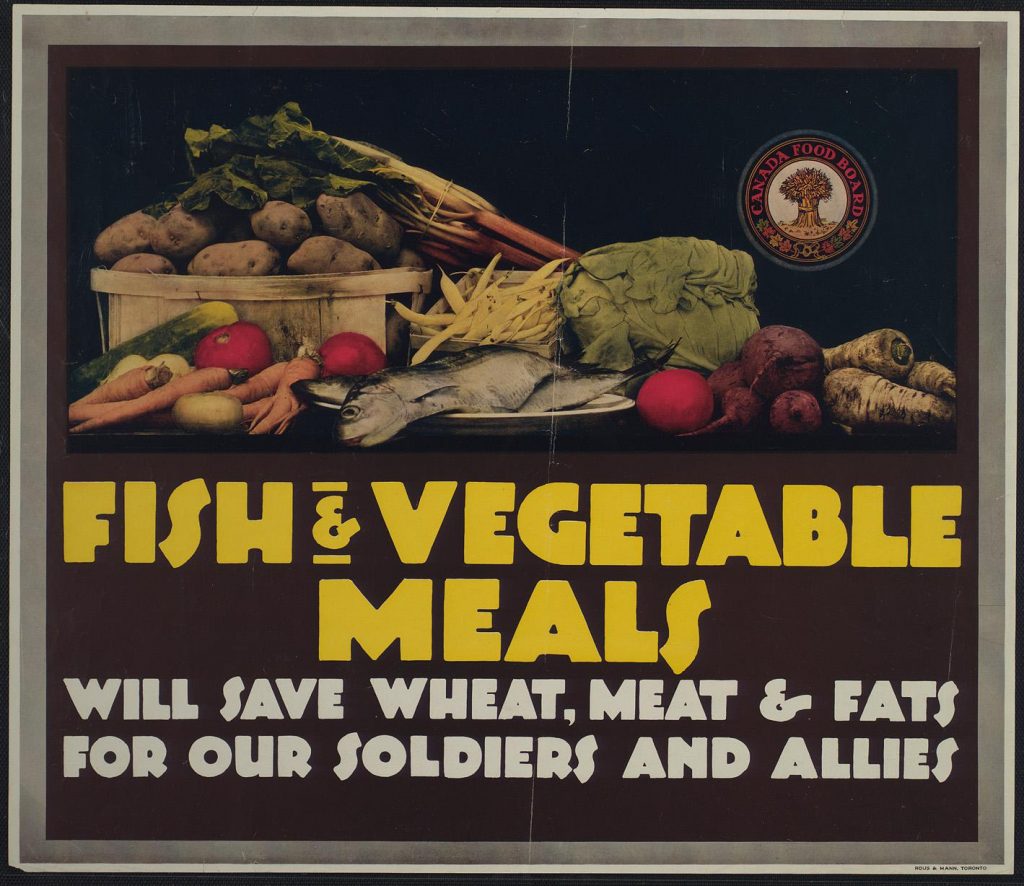Pacific salmon stocks continued to be abundant and thus a lucrative enterprise until the 1910s. However, as salmon stocks began to decline over the following decades due to over-fishing, conflicting interests, and obstructions in the migratory rivers conflicts arose between the Canadian and American governments.
W.J. Bowser, commissioner of fisheries, boasted in the Report of The Commissioner of Fisheries of British Columbia for 1911 that the catch of salmon “was the greatest of any of the years preceding”, with the exception of the big run in 1897. [i],[ii] However, fewer salmon reached the Fraser River than ever before “owing to the non-observance of any close times in the American waters of Puget Sound, [and] owing to the failure to limit the number of traps and purse-seines operating in those limited areas.”[iii]
There were no limits on the amount of salmon that the Americans could catch, nor was there a designated fishing season. The Americans had set up a wall of boats in American waters at the mouth of Puget Sound and were using seines and traps to catch the salmon as they migrated through the Canadian and American waters of Juan de Fuca and the mouth of the Puget Sound on their way into the Fraser River—with devastating results on the salmon fish stocks.
One of the conflicting interests was hydroelectric power. The first stage of construction began in 1910 on a hydroelectric power plant at Stave Falls. The seventeen-meter high and forty-six-meter-long dam would initially include four turbines and four generators. By 1916 local resident Albert Force is quoted in the June 20 Vancouver Sun that the fish in the Stave Lake were “suffering from some disease and those which have been caught have proved grubby.” The fish inspector blamed the timber in the lake.
Only 6 men listed their chief occupation as fisherman of the 1,531 men over the age of 15 living in the Maple Ridge area in the 1911 census—less than half a percent. However, directories and vital records paint a slightly different picture. The total population was 2,875 individuals.
[i] John F Roos, Restoring Fraser River Salmon: A history of the International Pacific Salmon Fisheries Commission, 1937-1985 (Vancouver: Pacific Salmon Commission, 1991) 10–13, 14–17.
[ii] Report of The Commissioner of Fisheries of British Columbia For The Year 1911, (Victoria: Government Printer, 1912), N 51. http://dx.doi.org/10.14288/1.0064424
[iii] Report of The Commissioner of Fisheries of British Columbia For The Year 1911, N 52.

City of Vancouver Archives, Thompson Photo, AM1376-:CVA 137-57, colourized with MyHeritage

By the 1911 census the Cheer family were dispersed. The grand-children of Daniel and Mary Cheer, (Philip, Archie, Lena, and Clara) were recorded as students at the Tulalip residential school in Tulalip, Snohomish, Washington.[i] In Canada, enumerator Peter Byrne, recorded sparse details of the Cheer family in Whonnock. Forty-year-old Harry Cheer, his thirty-five-year-old wife Mary Ann, and their six children and forty-year-old Daniel Cheer and his thirty-year-old wife Susanna and their two children were recorded.[ii] Peter Byrne did not record any occupations in his 1911 census enumerations, however, in his role as Indian Agent he reported that the members of the Whonnock reserve were employed in farming, fishing, and hop-picking.[iii]
The Nelson family are also dispersed by the 1911 census. Some of the family had moved upcountry while Anna and her sons, John, Isaac, Nels (and his wife Martha) went down to Washington.[iv] John and Isaac list their occupation as labourer while Nels is recorded as a merchant. Charles Hilmer Nelson and his family remained in Ruskin.[v] Alfred Nelson and his family also remained. Alfred is noted as a farmer in Whonnock. By 1919 the Wrigley’s British Columbia Directory notes Alfred’s occupations as “farming and fish collector.” Isaac Nelson married Mary Josephine Nolin of Whonnock in 1913 and listed his occupation as fisherman.[vi] He listed his residence as Edwards. Isaac knitted his own gillnets from linen twine.[vii]
When Hokon Julius Nelson, (son of Ole Nelson and Mary West aka Martha Marie Lee Nelson) was drafted into the Canadian Army in November 1917 he listed his occupation as fisherman and his residence as Anniedale.[viii] His mother Mary was living in Pender Harbour.
In 1911, Charles Henry Owen, age fifteen,was living with his widowed mother, Mary, and his seven siblings. He listed his occupation on the 1911 census as a farmer’s son. Charles began fishing in 1913 as a teenager.[ix]
Robert Robertson had retired by the 1911 census. He listed his occupation as a gentleman. He died in late April 1912.[x]
[i] 1910 United States Federal Census, Tulalip, Snohomish, Washington; Roll: T624_1669; Page: 17B; Enumeration District: 0314; FHL microfilm: 1375682, [database on-line]. Lehi, UT, USA: Ancestry.com Operations Inc, 2006.
[ii] 1911 Census of Canada. Census Place: 47, New Westminster, British Columbia; Page: 52; Family Nos: 29 and 31. Library and Archives Canada. Census of Canada, 1911. Ottawa, Ontario, Canada: Library and Archives Canada, 2007. Series RG31-C-1. Statistics Canada Fonds. Microfilm reels T-20326 to T-20460.
[iii] Dominion of Canada Annual Report of The Department Of Indian Affairs for The Year Ended March 31 1912 (Ottawa: Government of Canada, 1912), 238.
[iv] The National Archives at Washington, D.C.; Washington, D.C.; Manifests of Passengers Arriving at St. Albans, VT, District through Canadian Pacific and Atlantic Ports, 1895-1954; Record Group Title: Records of the Immigration and Naturalization Service, 1787 – 2004; Record Group Number: 85; Series Number: M1464; Roll Number: 154.
[v] 1911 Census of Canada, Census Place: 40 – Dewdney Riding, Maple Ridge Municipality, New Westminster, British Columbia; Page: 8; Family No: 79.
[vi] Marriage of Isaac Nelson and Mary Josephine Nolin, Isaac states his occupation is fisherman. British Columbia Marriage Registrations (British Columbia Archives), Registration Number: 1913-09-099056, BC Archives Mfilm Number: B11381, GSU Mfilm Number: 1983709. Event Date: September 16, 1913.
[vii] “Jacob I. Nelson”, profile compiled by the North Pacific Cannery.
[viii] Hokon Julius Nelson, World War I Attestation, Regimental Number 2021506, Library and Archives Canada, Military Heritage, Personnel Records of the First World War
[ix] 1911 Census of Canada. Census Place: 39, New Westminster, British Columbia; Family No: 18. Library and Archives Canada. Census of Canada, 1911. Ottawa, Ontario, Canada: Library and Archives Canada, 2007. Series RG31-C-1. Statistics Canada Fonds. Microfilm reels T-20326 to T-20460.
[x] 1911 Census of Canada; Census Place: 40 – Dewdney Riding, Maple Ridge Municipality, New Westminster, British Columbia; Page: 5; Family No: 44. Library and Archives Canada,


Courtesy the Hertzog (Baker) family, colourized with MyHeritage
The Baker family has deep roots in Maple Ridge, however their connection to the fishing industry is not evident in the records until the 1911 Canadian census. British Columbian born Alexander is listed as a twenty-two-year-old fisherman working on the Fraser River.[i] His twenty-four-year-old wife Senny listed her nationality as Finnish. She immigrated in 1900. Alexander, Senny and their two children, Leslie and Alvie, are living with Alexander’s British Columbian born widowed, sixty-seven-year-old mother Mary. Alexander’s sister Florence and her husband William Frost live nearby. William is also a fisherman although the census records him as a carpenter. Alexander and Florence are the children of Pierre Ferdinand Boulanger and Mary Lafleur Brousseau who Anglicized their name to Baker sometime before 1881.
[i] 1911 Census of Canada, Census Place: 39, New Westminster, British Columbia; Page: 4; Family No: 37. Series RG31-C-1. Statistics Canada Fonds. Microfilm reels T-20326 to T-20460. Library and Archives Canada.


1917
Maple Ridge is unique in that the district did its own census in 1917. The total population was 2,120 people, though it did not include the reserves and thus the Cheer family is not included. What is interesting about the census is that it reflects the focus of the Canadian government on increasing agricultural production during the First World War. Canadians were encouraged to produce eggs and meat to send to the troops and Allies overseas. The 1917 census noted the number of cattle, hogs, and poultry at each home. Alonzo, Alex, and widows Mary Baker and Mary Owen are in township 12, between 216th and 264th Streets, and listed as freeholders. Interestingly, August is listed as Boulanger rather than Baker. August, Alonzo and Mary Baker are all recorded as having poultry. Townships 14 and 15, between 264th Street and Pitt River and south of 96th Avenue along the Fraser River, include N.C. Nelson, though no livestock is listed for him.[i] While the people involved in the fishing industry are not noted on this record, the Canada Food Board encouraged Canadians to eat fish rather than meat and so created a demand at home in addition to the tins of canned salmon being sent to England.
Around the time of this census, the District of Maple Ridge tried to attract more investment and residents, through a story in the January 2, 1917 British Columbian titled “Seventy-two square miles of Prosperity.” The sport trout fishing was described as “excellent, three of finest trout streams in British Columbia flowing through the municipality—the Lillooet and North Lillooet river and Kanake [sic] creek. Commercial fishing for salmon is an important business on the Fraser in the season [for] several hundred fisher[men] along the waterfront of Maple Ridge, their catch being collected daily by boats from the canneries downstream”. The 1917 census also noted that 137 men were soldiers. However, the record does not include Charles Henry Owen—he listed his occupation as a fisherman on his attestation papers in January 1916.[ii] Charles fought at Vimy Ridge and the Battle of Passchendaele and returned home with damage in both legs and a shoulder from gunshot wounds.
[i] “Enumeration Maple Ridge 1917”, Whonnock Notes No. 17, Fall 2008.
[ii] “Fishing on the Fraser”, Ridge/Meadows Times, August 7, 1985, 3. Second source: Library and Archives Canada; Ottawa, Ontario, Canada; CEF Personnel Files; Regimental No. 790458; Reference: RG 150; Volume: Box 7517 – 47.

Read more…
We acknowledge that the land on which we live, work, and play is the traditional and unceded territory of the Katzie First Nation and the Kwantlen First Nation Peoples. We respectfully honour their traditions and culture.